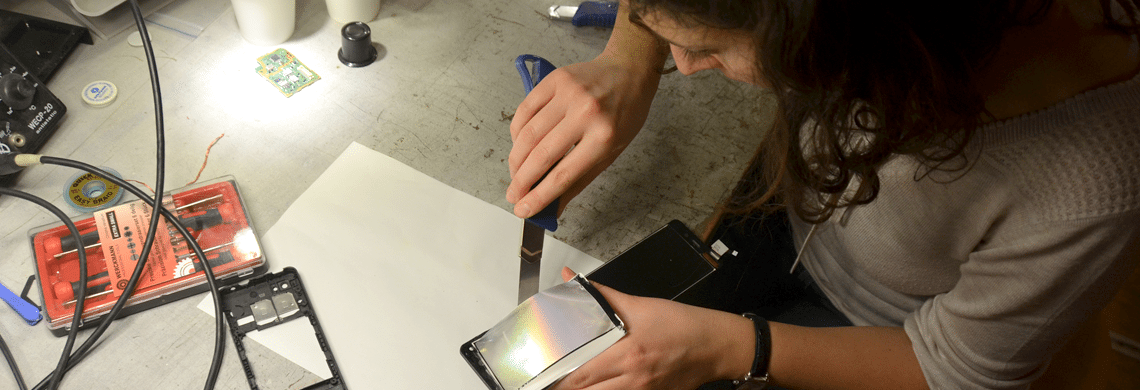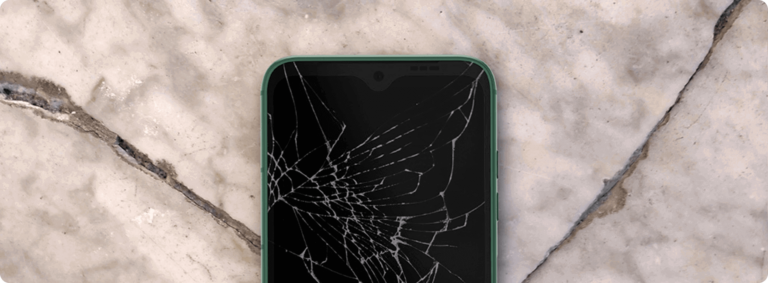Examining the Fairphone’s environmental impact
Nearly a year ago, I first came to the Fairphone office ready to start my role as a research assistant and dig deeper into the Life Cycle Assessment (LCA) work started by my predecessor Artúr Szilágyi. In the meantime, I’ve learned more than I ever anticipated about the first Fairphone’s components and completed the inventory analysis phase of the LCA, and as well as finished my thesis and graduated with a degree in Industrial Ecology. And now I’m ready to share my final LCA results with you.
To refresh your memory, LCA is a quantitative tool used to assess the environmental impact of a product or service. The goal of my research was to find out how we could improve the Fairphone’s environmental performance. To be able to answer this, I looked at three questions:
1. What is the environmental impact of the Fairphone throughout its life cycle?
2. Which eco-design tools could be used to improve the environmental impact of the Fairphone?
3. What is the environmental gain of applying improved design options to the Fairphone?
Examining three impact categories: climate change, metal depletion and human toxicity
My first goal was to understand where the environmental impact arises, especially in the following categories: climate change, mineral resource depletion and human toxicity, as they are the most affected impact categories for electronic devices according to Schischke’s research (2013).
My previous blog post on inventory analysis explained the goal, scope definition and data collection process I used to conduct the analysis. I chose the functional unit as “the use of a Fairphone and its battery with an average lifetime (3 years) and average daily use time of the Fairphone users.” (This average lifetime was established from a survey with Fairphone owners.) I modeled the system in CMLCA, a LCA software tool developed by the Institute of Environmental Sciences at Leiden University in the Netherlands.
Here are the results for all of the impact categories:
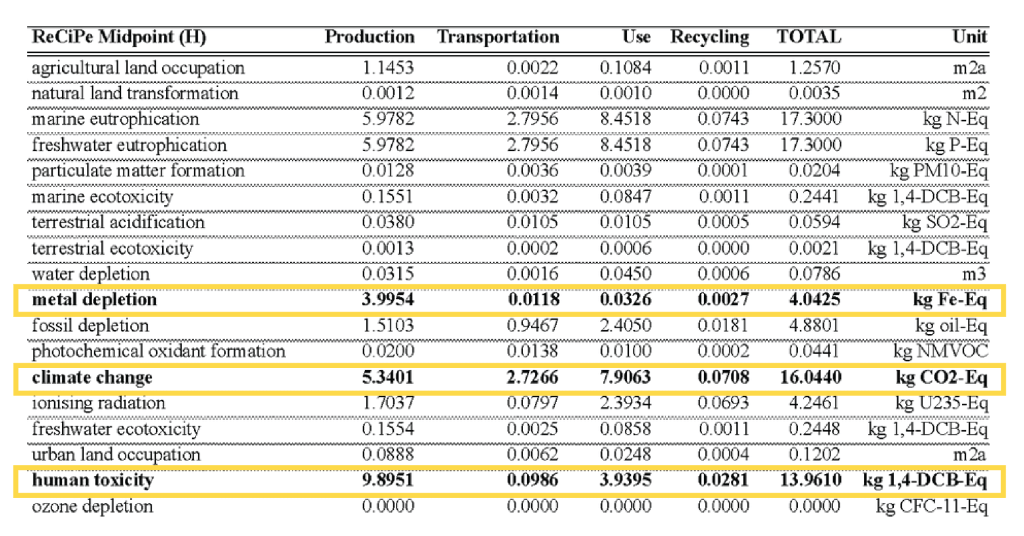

It doesn’t say much, right?
In order to get a more meaningful understanding of these numbers, I conducted a contribution analysis to see the how the different product life cycle stages or the production of certain components affected theses three impact categories.
This allowed me to identify the “hot-spots” in the mobile phone life cycle that are causing the greatest environmental impact.
The production phase (see Figure 1) consists of the production of the components and the assembly activities. The transport phase represents the transportation of the mobile phone from the manufacturing facility in China to the Netherlands, as well as the movement of materials and goods used in production. The recycling phase includes the combination of the recycling processes of the Fairphone and the battery.
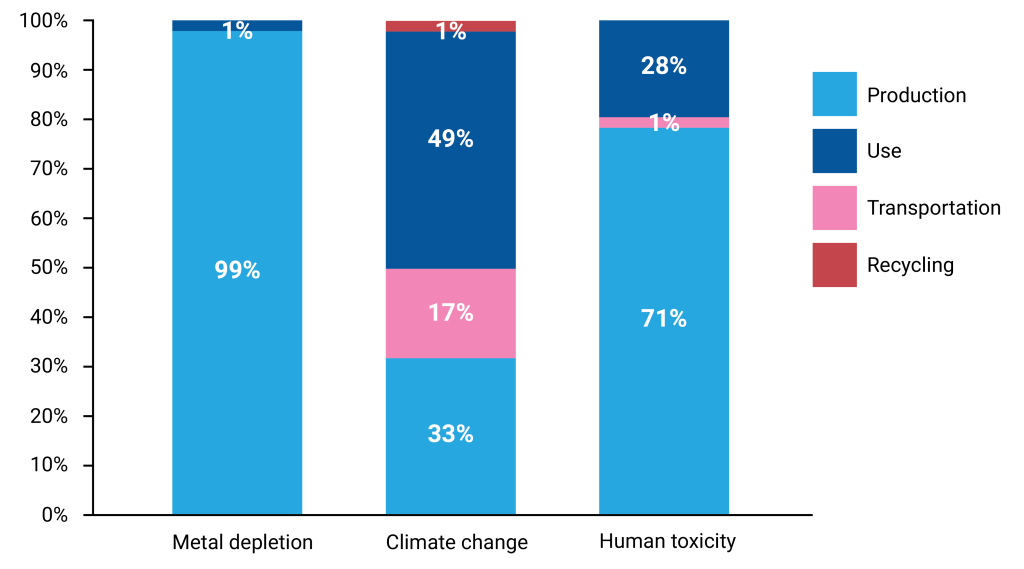

To understand the impact of each sub-component in more detail, I’ll walk you through a few figures representing metal depletion, climate change, and human toxicity. So what is the environmental performance of the Fairphone throughout its life cycle?
Let’s take a closer look at these three categories:
1. Metal Depletion: (Figure 2)
Metal depletion measures the extraction rate and remaining reserves of metals, creating a reference unit of kilograms Iron equivalent, also referred to as kg Fe-eq. So that all the metals used throughout Fairphone’s life cycle are converted to values in Iron “kg Fe-eq.” is the unit chosen in order to convert other values of materials into one unit to make the life of LCA experts easier.
The Fairphone results in 4.04 kg Fe-eq. of metal depletion for the functional unit.
Ninety-nine percent of this impact comes from the production phase, which consists of the production of the components and assembly activities.
Among the components used to produce a Fairphone, the battery has the highest contribution to metal depletion with 1.5 kg Fe-eq, followed by the PCB with 0.69 kg Fe-eq., integrated circuits with 0.47 kg Fe-eq. and the LCD screen with 0.36 kg Fe-eq.
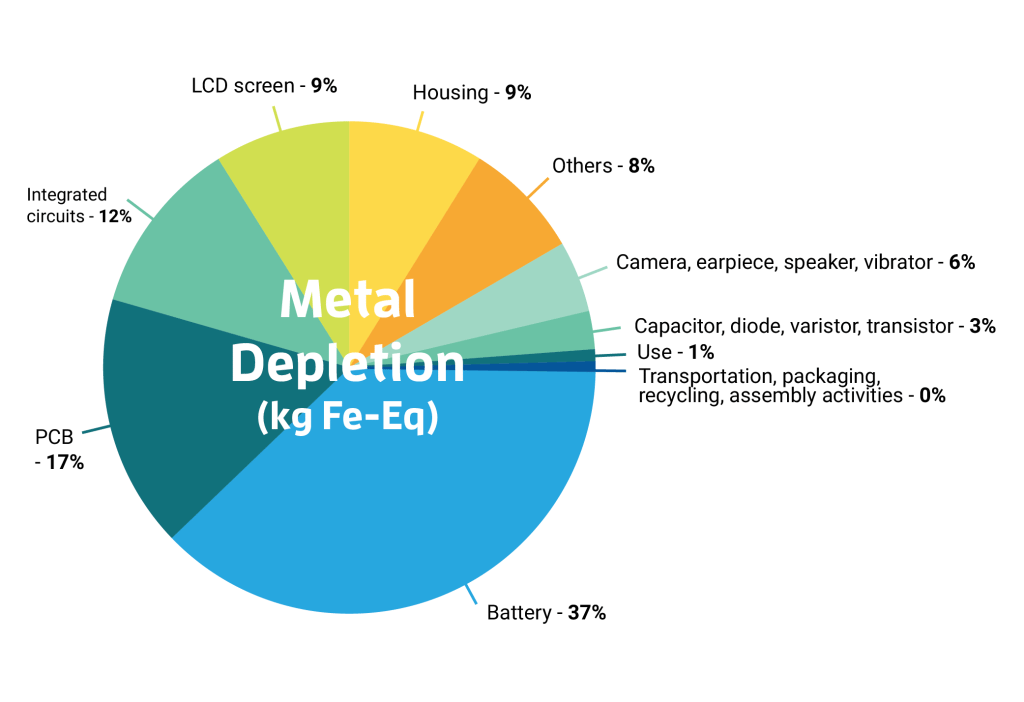
Climate change is the impact category which is of greatest interest to Fairphone. It measures how much heat is trapped in the atmosphere by greenhouse gases caused throughout the Fairphone’s life cycle. In total, the system emits 16.40 kg CO2-eq. Compare that to making a cup of black coffee – 21 g CO2eq.
Nearly 50% of the greenhouse gas emissions come from the electricity used to charge the phone during the 3-year usage scenario.
The use phase analysis only includes electricity consumption from charging the phone. If network usage (e.g. text messaging, voice calls, data transfer and energy consumption of cloud servers…) were included as well, then this result would be even higher. In terms of overall impact, the use phase is followed by the production phase (33%) and transportation (17%). The top three contributors among the Fairphone’s components are the LCD screen with 11% (1.85 kg CO2-eq.), integrated circuits with 5% (0.76 kg CO2-eq) and the PCB with 4% (0.59 kg CO2-eq).
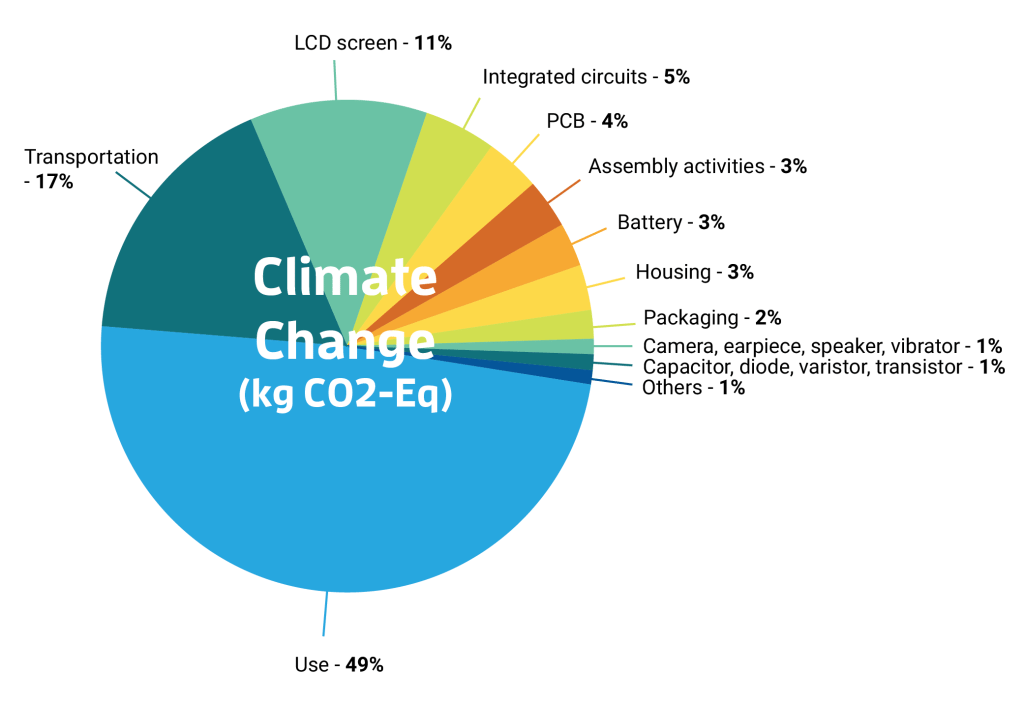


3. Human Toxicity: (Figure 4)
The emission of some substances like heavy metals can have impacts on human health. The human toxicity reflects the emissions of toxic substances having a detrimental effect on human health.
It was no surprise that production of the Fairphone’s components is the main source of human toxicity impact.
The highest contributors are the integrated circuits (24%), battery (16%), LCD screen (9%) and PCB (8%). The use phase is also responsible for 28% of the human toxicity. The transportation and recycling phases have very low contributions – about 1% in total.
* Sad truth: Performing an LCA assumes that every part of the electronics process can be “toxic” when introduced into life systems of air, water, or human consumption. This is the case for all electronic devices, and that is why it is important that we recycle them properly so that the substances in them don’t enter in contact with human life systems.
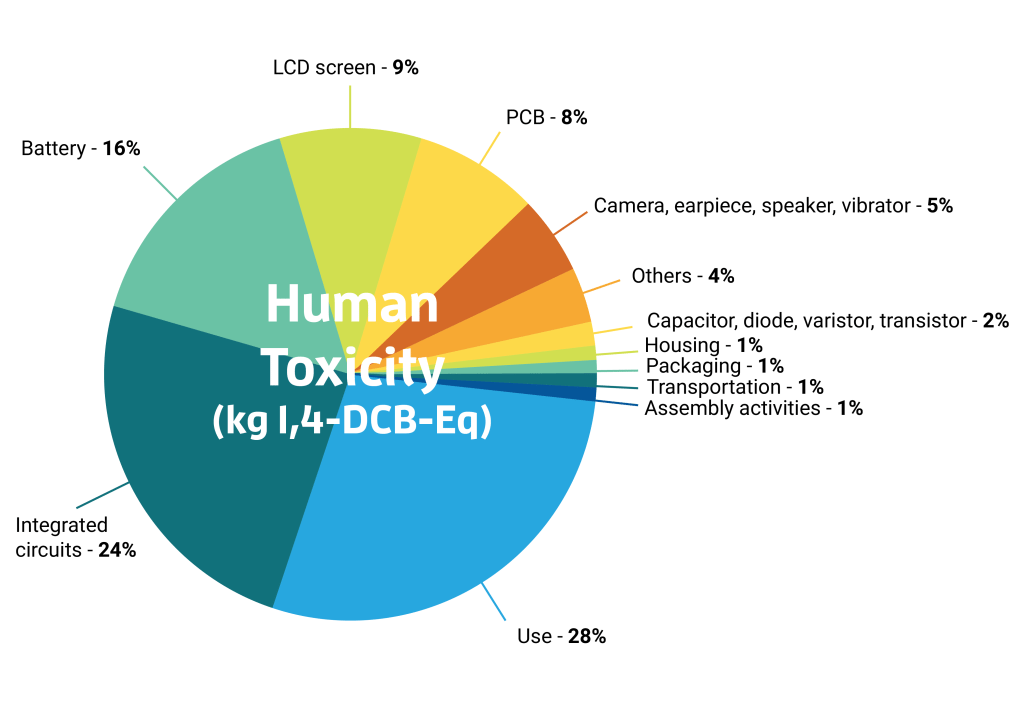
Identifying potential improvements to environmental impact
In summary, looking at the above contribution analysis, the “hot spots” of the system are the use phase, LCD screen, printed circuit board, production of the integrated circuits and battery, and the transportation of the phone from the factory in China to the Netherlands by air. Looking specifically at these areas, here are some potential ideas for improving the Fairphone’s environmental performance:
Battery and use phase
Throughout a 3-year usage scenario, based on the maximum charge cycle and average charging time per year, it is assumed that Fairphone owners will buy an additional battery.
If the software is designed having more influence in brightness screen settings (as well as in the use of the processing power), there are hints that point to the battery life becoming extended and hopefully lower the need for a battery replacement.
However, user behaviour also plays a role here, eg charging your phone every night independent of the energy remaining.
LCD screen
Switching to an AMOLED screen could be a potential solution for reducing carbon emission by less electricity consumption due to efficient battery usage (Lin et al., 2009), though more up-to-date research is necessary to validate this claim. On the other hand, there are not yet any studies analyzing the environmental impact of producing these screens. Further, there are some challenges for an organization of Fairphone’s size to get supply of such a screen model. Currently only a few vendors are commercializing viable AMOLED displays.
The LCA is calculated with the assumption that users never break their screen.
Each time a broken screen needs to be replaced, one’s environmental bill adds up. For example, your CO2 emissions will increase by 11% if you buy a new screen.
As of January 2015, an estimated 3% of Fairphone owners have reported a broken screen. Further study is needed to research in which situations users drop their phones in order to improve future phone design. (In the Netherlands, drops from bicycles are perhaps proportionately higher than elsewhere.)
Transportation
Transportation has a major impact on climate change, which mainly stems from transporting the Fairphone from China to the Netherlands by air. If the phones are transported by boat or rail, this impact could easily be reduced. As these alternatives were discussed internally, it became clear that timing was a concern, as both options take longer than the current means of transport. For instance, shipping by boat is around one month. Rail takes about 21 days to Europe. Beside delivery duration, security and availability of that shipping option were also concerns, especially for rail transportation. However, recent developments (like this new direct rail link from China to Spain) might make freight trains a viable option for the future.
What is next?
After researching the opportunities for improvement, I wanted to create a future vision for the Fairphone. First, I reviewed literature and went through different tools, guidelines and concepts. After my assessment, I chose the Circular Economy framework that can be broadly defined as an economy that is regenerative and waste-free by design. This results in a framework that poses a vision to a future technological cycle in which products live longer, are repaired, re-used or recycled in order to extend the lifetime (or make infinite) of the materials used to make those products.

I had two reasons for choosing the circular economy to improve the sustainability of the Fairphone. First, several aspects of the circular economy concept have already been integrated into Fairphone’s approach to previous business decisions. Second, the circular economy was very interesting from an academic perspective, as there are not yet any studies that apply specifically to mobile phones.
Scenarios for a more sustainable Fairphone
Keeping the circular economy in mind, I created four potential scenarios for the future. To be able to better compare their impact with the baseline, I looked at these various scenarios over a time span of 6 years.
Smartphone Scenario
In order to understand the environmental impact of shorter life spans, I developed this scenario with the assumption that buyers would use their Fairphone for only two years. This means that they would buy three phones in six years. This is close to the average smartphone use life in Europe.
Fairphone Baseline Scenario
The baseline scenario has the same assumptions as the main LCA. Fairphone owners use their phones on average for 3 years. So over 6 years, they would need to buy two phones.
Refurbishment Scenario
In this scenario, I assumed that buyers would use one Fairphone for 6 years by getting some of the components repaired.
Circular Scenario
This scenario is almost the same as the refurbishment scenario, except for one thing: After the phone is used for 6 years, it would be returned to Fairphone. The company would dismantle the smartphone and use the functioning components to repair other phones. Broken or unusable components would be recycled.
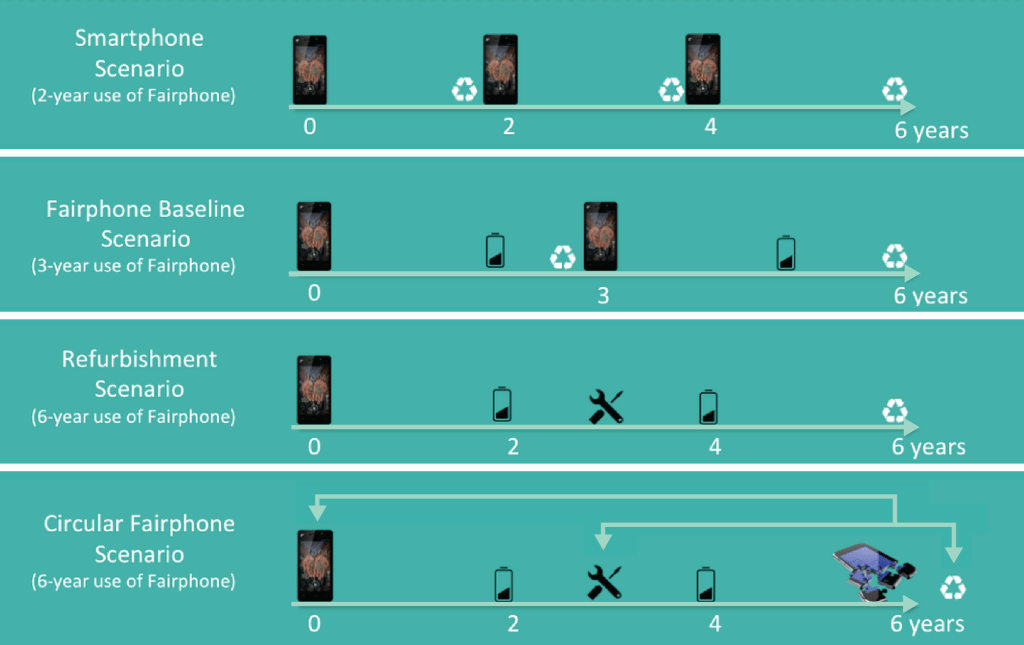
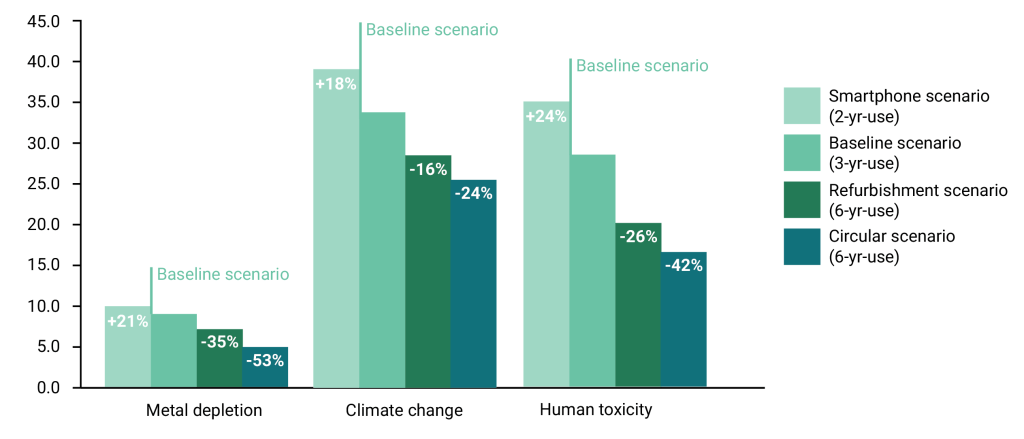
The “General” Smartphone Scenario shows that Fairphone needs to address the decreasing lifetimes of smartphones.
If Fairphone customers use their phones for only two years, metal depletion will increase by 21%, climate change by 18% and human toxicity by 24% when compared to using the phones for three years. So please keep your Fairphones as long as you can!
What if you use your phone for six years instead of three? It makes a considerable difference, causing 35% less metal depletion, 16% fewer CO2 emissions and 26% less human toxicity. As you can see, if we use our phones longer and Fairphone provides spare parts and effective repairs, then it can easily improve environmental performance.
The Circular Scenario provides even greater opportunities for improving the environmental performance of the Fairphone in the long term. Compared to the current situation (Baseline Scenario), it would result in 53% less metal depletion, 24% less climate change and 42% less human toxicity. In this instance, customers should still be persuaded to use their phones for six years. But this approach would also require additional infrastructure and investments such as a facility to dismantle used Fairphones and refurbish others. More research is needed to determine the feasibility of setting up a dismantling facility and the recovery rate of materials.
Recommendations for improving environmental performance
So how can we improve the environmental performance of the Fairphone? After completing my research, it seems that the answer lies in applying the concepts of a circular economy, and Fairphone is continuing their efforts in this line joining the Circle Economy cooperative and starting new projects (Circular Economy/Fairphone project). As explained in the scenarios, the greatest improvement to environmental performance would come from prolonging the usable lifespan of the phones.
To achieve this, Fairphone can educate their customers about the importance of using their phones for longer and can combine this change in user behavior with good service and repairs. This first option is easily achievable.
A second option is to ensure that Fairphones are collected when they reach the end of their lifespan, and if possible reuse them as refurbished phones. If the phone is no longer functional, it should be recycled, of course.
A third option is to explore new business models – for example, one where ownership stays with Fairphone as opposed to individual consumers. Instead of selling the Fairphones, they could be leased and then fixed (at the end of the lease term) before being leased again in different markets. It has been researched (see the Ellen MacArthur Foundation reports) how retaining ownership of products within a company can influence design to come up with more long-lasting products and in general have more control in the life-cycle of the product. As the primary production of components stands for nearly half of the environmental footprint of a device and the primary area where raw materials are used, this can represent a major benefit for environmental performance.
The fourth option is to have a dismantling facility for Fairphones. When the phone is no longer functional, the usable components could be used for refurbishing other Fairphones or even in other products. For example, old cameras could be used in medical devices and toys.
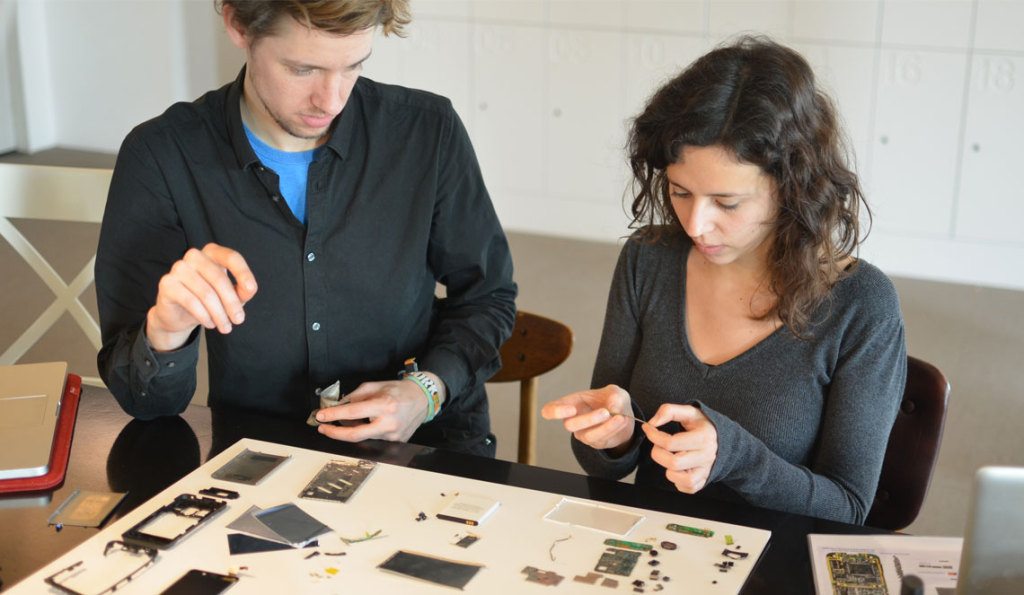
We would like to thank Merve for her hard work and valuable LCA research and recommendations. The above blog post is just a small sample of the detailed analysis and findings. If you’re curious to know more, you can download and read her full study here.
As Merve mentioned, the goal of the LCA research was to identify environmental impact hot spots in the entire lifespan of the Fairphone to help us make decisions that will improve the next phone’s environmental performance. The results of Merve and Artúr’s research confirm that we are on the right track with our ambitions for longevity. Going forward, we will certainly inform Fairphone owners about the importance of using their phones for as long as possible, and continue to make improvements to our (self) repair, spare parts and service offerings to help enable this. For the new Fairphone design launching in 2015, environmental performance will also play a role in certain components and suppliers that we select.
While all of these recommendations for improving the Fairphone’s environmental impact are well worth exploring, some are simply not feasible in the short term. For example, at the moment, shipping from China by train is still a risky option. This is an instance where time constraints and security issues related to overland/sea transport will unfortunately have to take precedence over carbon emissions; but we are investigating alternative options when new shipping methods mature. We will certainly aim for a six-year usage scenario for Fairphones in the future, but at the moment, we are not convinced that other essential industry players (such as chipset manufacturers) are currently able to support phones for this extended duration. Finally, we hope to someday reach a point when the Fairphone is a true example of circular economy principles, where used phones and components could either be completely recycled, used for repairs or incorporated into new phones. The future is exciting. Even though a full circular model remains very challenging, we are making new steps going forward as we join efforts with initiatives like Circle Economy.
